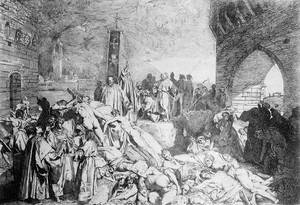
Boccaccio’s description of the outbreak of the Black Death in Florence in 1348 is a valuable source of information not only for historians but also for those who study human behaviour under extreme conditions. As an eyewitness the author of the Decameron reported in details how different groups and classes of the medieval city reacted to this unprecedented disaster which changed the entire course of European history.
Florence’s municipal authorities took a number of measures to prevent the spreading of the disease: “huge amounts of filth were removed from the city; sick people were forbidden to enter the city; advice was given on how to stay healthy”. This description shows that in the 14th century cleaning, quarantine and public warning were already considered necessary to stop infection. But the above prophylaxes combined with numerous “humble supplications to God” made by “devout persons” proved inefficient against “the bubonic plague”. Boccaccio’s description of the sickness symptoms is somewhat imaginary but reflects well the lethal character of the Black Death.
At the beginning, many citizens did not realize the virulence of the plague because “a multitude of people, male and female, with no medical training” tried to cure it, obviously, in vain. But as soon as they noticed how quickly this mortal infection was spreading they adopted “the cruel strategy” “to avoid, even flee the sick and their belongings”.
Boccaccio dwells on behaviour of different groups of wealthy Florence’s citizens faced with the Black Death. Some preferred moderate living in isolated “small groups” “shutting themselves up in houses where no one had been sick” and avoiding any contact with “the death and illness outside”. Others, on the contrary, decided “that drinking a good deal, singing and having fun, laughing and joking” would be the best remedy for them. They indulged in “this bestial behaviour” day and night in taverns and abandoned houses which “had become common property” after their dwellers died or fled. Many rich citizens neither secluded themselves nor sank into debauchery but when going outside had to carry “flowers, fragrant herbs or various spices” in order to fight “the stench of dead bodies and illness”. “A large number of men and women” escaping from “the pestilence” “abandoned their city, houses, families and possessions” and went to the countryside.
In this horrible situation the very fabric of social order and family ties started to disintegrate. Florence’s civil and clerical authorities “could not perform their offices” and help the population. Everyone who fell sick was abandoned by friends, neighbors and even often family members. Even for “huge salaries” it was “hard to find” servants for people attained with plague. Sick women “no matter how attractive or beautiful” they were had to reject all shame and hire male servants to look after them. In Boccaccio’s opinion this “unheard of practice” loosened morals of survivors.
The number of people dying every day was really shocking. That’s why all funeral customs and practices changed tremendously. Even wealthy citizens were accompanied to the burial place by a few relatives and neighbors and “often none at all”. Boccaccio seems somewhat troubled by the lack of respect to dead personalities whose coffin was brought by gravediggers to the closest church and put in the first “unoccupied sepulchre” in the presence of a few clergymen without “any lengthy, solemn services”.
But the situation of poor and middle class citizens was much worse, they had no means to leave their dwellings that’s why “they fell sick by the thousands every day and almost always died”. Copses were dragged out of the houses and collected in the streets without much ceremony. Most probably this necessary work was done under the auspices of the church represented by “two priests with a cross”. The majority of poor people were buried nameless in huge common trenches “by the hundreds”.
The countryside surrounding Florence was not spared by the Black Death. There “poor, miserable peasants and their families, who lacked the care of doctors of the aid of servants, died more like beasts than humans”. In anticipation of their death they stopped caring about their possessions, fields and domestic animals.
In conclusion, Boccaccio informs us that “more than one hundred thousand people died within the walls of Florence”. He mourns deeply for his most distinguished, wealthy and noble fellow citizens ravished by the Black Death.
Bibliography
“Boccaccio on the plague” trans. David Burr. online at http://www.history.vt.edu/Burr/Boccaccio.html